Table of Contents
When I used to hear people asking for masala chai tea, the first thing that came to my mind was, “Why are they asking for tea.”
The word “chai” is derived from the Chinese word for tea, “chá (茶),” which is used in India and many other parts of the world to describe tea.
Chai is associated with a spiced blend beverage, masala chai, often served with milk, but it has little to do with how it began.
How It All Began
The “real” and “true” story is based on a 5000-year-old legend. A king existed long ago somewhere in India or Siam who wanted to help his people live a healthy and long life. He ordered a unique medicinal beverage to be created and used in Ayurveda, a traditional therapeutic practice in which herbs and spices are used for healing. It is considered by many to be the oldest healing science. In Sanskrit, Ayurveda means “The Science of Life, and here in the West, we can probably say” the predecessor of Homeopathy.”
Herbs and spices were blended in myriad ways and used as medicine or just drunk for good health. The blend of these spices is called masala, hence masala/chai or “spiced tea.”
The chai at that time had little to do with the chai as we know it today; black or green teas were not part of the recipe. It was a spiced beverage drunk hot or cold for medicinal purposes or minor aches.

It was not until the 1830s that the British East India Company saw the abundance of Assamese tea plants. It decided it would be an excellent opportunity to compete against the Chinese tea producers. Until 1870, 90% of Britain’s tea consumption was made from China.
The demand for tea in Britain was ever-growing, and the dependency on China for tea supply was strange at that time, considering the British controlled about one-fifth of the world. Yet, they were unable to acquire the seeds needed for growing tea.
They couldn’t control the price or the quality of the tea, as the Chinese had a monopoly over tea production, leading to the opium trade. They sold opium to the Chinese and used the proceeds to buy tea and silk. That eventually led to two Opium wars between 1839 and 1860, as the governing Qing dynasty was not very happy with the country’s increased consumption and opium addiction.
By the mid-1800s, the East India Company was losing the tea trade monopoly, and they were looking to establish their plantations in the Northeast of British India. There were just two problems:
- India didn’t have the Chinese Sinensis tea plant variety; Assam had the assamica plant.
- The company didn’t have the expertise to grow and produce tea. They needed to find seeds, Chinese gardeners, and the know-how of the whole process.
Then, in 1848, something changed the landscape of tea production forever.
“greatest single act of corporate espionage in history”
Sarah Rose in her book For All the Tea in China – Espionage, Empire and the Secret Formula for the World’s Favorite Drink
Enter the world of Robert Fortune, botanist, gardener, and spy. He was hired by the East India Company for a clandestine trip into China’s interior territories, forbidden to foreigners, with one mission – to steal the closely guarded secrets of tea. Secrets carefully guarded for centuries had to be acquired and brought to British India. In the end, he completed getting the seeds and secrets of tea making to the East India Company. In the following decades, India became a world-leading tea producer until 2006, when China gained the world’s top producer.
Note: After a century, Robert Fortune, a botanist, didn’t think of his actions as property theft. For him, plants didn’t belong to anyone, and people were free to share and use them. The British invested in cultivating tea plants and developing local grower plantations. As a result, by the turn of the 1900s, almost 90% of the imported teas came from India and Ceylon.
In India, the people were not trying the newly discovered tea, and the consumption was pretty low. They preferred their old traditional ways. The British East India Company had to do something to change that and develop the demand for tea in the domestic market.
At the beginning of the 1900s, the British-owned Indian Tea Association developed a brilliant marketing campaign geared toward employers giving the workers “tea breaks,” which meant the employees now had more time to drink tea. They even supported many “chai wallahs” – tea vendors throughout the growing railway system.1

The steps they took to change most people’s low demand and resistance towards tea are fascinating.
In 1903, the Tea Cess Committee, renamed 1933 the Indian Tea Market Expansion Board, was established to promote local consumption because the tea was unfamiliar to consumers. Instructions on how to drink it were included, and small packages were even given away for free.
Before 1920, the Indian Tea Association comprised British companies focused on exporting tea and developing the large US market. Even though the demand was there, retail tea prices were flattening. Combining this price trend with the US’s significant financial and economic turmoil during the Great Depression made it more financial sense for them to concentrate their efforts on developing the local market.
The problem was, besides the North, where they had been drinking tea for centuries, and the tea port of Calcutta, the rest of the country didn’t fancy boiling leaves with milk, water, spices, and sugar.
Negative public opinion was a significant obstacle to adopting tea, fueled by people such as Acharya Prafulla Ray, an eminent chemist and passionate nationalist who, in 1920, published cartoons equating tea with poison.
Another widely held belief was that tea made the skin darker; at that time, many people were obsessed with fair skin, and tea was off the menu.
Gandhi strongly opposed the intake of tea and put it in the same class of avoidable substances like tobacco and cacao. He called tea
“an Intoxicant …and tannin when taken internally impairs digestion and causes dyspepsia.” Instead, he suggested that honey, hot water, and lemon as nourishing drinks.
Mahatma Gandhi book, A Key to Health 1942, p.21

He wrote that the Chinese only drank tea because the water was contaminated and needed to be boiled. Since boiling tea leaves changed the colour of the water, the leaves were used to decide if the water was safe to drink.
Some clever Chinaman discovered a grass called tea which when
Mahatma Gandhi book, A Key to Health 1942, p. 21
added to boiling water in a very small quantity gave it a golden colour. The
colour did not appear unless the water was really boiling. Thus the grass
became an infallible test for seeing when a given quantity of water was boiled
The Indian Tea Association was persistent in its efforts to change public opinion. It illustrated advertisements at railway stations, and new tea shops were popping up along the railways. Boiling was introduced as an antidote to “poisonous” tea, and the advertisements promoted health benefits such as “increased stamina.”

Initially, the tea vendors were instructed to sell the chai according to the Indian Tea Association’s recommendation for tea with a small amount of milk and sugar2, but that didn’t go very well, as the locals liked their Masala chai. They added spices, more milk, and sugar to the tea.
The Tea Association didn’t like adding more milk, diluting the tea and cutting their profits. But eventually, the local taste and preferences prevailed, and that’s how the masala chai, as we know it today, was born.
Another significant increase in popularity happened in the 1960s with the development of a new tea-producing technique, CTC (cut, tear, curl), producing inexpensive tea capable of fast infusion and intense flavour.
Intense flavour is an essential quality of tea in making chai; when we mix something with milk, we need the flavouring agent to have enough aroma to cut through the heavier texture of the dairy product. Think of making White Russian; unless we use lots of Kahlua, we will barely notice the coffee aroma.
Main Tea Producing Regions in India
India and China are two of the world’s biggest producers and consumers of black tea. Some of the primary producing states in India are Assam, West Bengal – Darjeeling, Tamil Nadu, and Kerala. Many are black tea producers, but recently, much diversification has developed, especially in the Darjeeling region, known for oolong, green, and white tea. Not every area in India is suitable to grow good quality tea, as it requires specific climate conditions with lots of moisture. This is one of the reasons the major tea-producing areas are located in the Northeastern part – Darjeeling and Assam, and in the South – Nilgiri and Kerala.
source:https://www.indiatea.org/tea_growing_regionsIndia’s production is 1.2 million tons annually, contributing 4% to the national budget. Half of it is consumed locally. The significant regions are Assam and Darjeeling.
| Two of the Major Indian Tea production areas | Characteristics |
|---|---|
| Assam Tea | Darjeeling is located high in the foothills of the Himalayas. It is spicier than the Assam tea, and, as recommended by the Tea Board of India, is to be drunk with no milk or sugar, also frequently referred to as the “champagne of teas.” |
| Darjeeling Tea | Darjeeling is located high in the foothills of the Himalayas. It is spicier than the Assam tea and, as recommended by the Tea Board of India, is to be drunk with no milk or sugar, also frequently referred to as the “champagne of teas.” |
Sri Lanka/Ceylon Tea
Formerly known as Ceylon, Sri Lanka is the world’s fourth-largest tea-producing country, with around 340,230 tons. The British introduced the crop in the 1860s to boost production and compete with China.
Currently, one of the major exporters of Orthodox teas is Ceylon tea. Mainly known as black tea, Ceylon tea comes in different varieties, including green and white. No single tea description exists, as seven distinct regions have distinctive characteristics and flavour profiles. Still, the taste ranges from citrus to spicy, essential if drunk traditionally. In masala chai, however, the spices will overpower the delicate tea aromas, and choosing which tea to use is a matter of personal preference.
Spices used in chai
The type of spices used in the spice blend/masala is the all-important part of making masala chai, as it provides a specific aroma to chai. Back in time, they chose which spice to be used based on their potential health benefits. There is no rule or particular recipe standard to judge what is good or lousy masala chai, as probably every household in India has its recipe. In general, it is accepted that few spices are usually present in the spice blend; fresh ginger, black peppercorns, mace, cardamom, cloves, and star anise are some.
Using all or some is about personal preference, like creating a cocktail. Not having a set recipe allows people to experiment and make masala chai fun.
Spice Flavor Profile
Cardamom (Elaichi) –Elettaria Cardamomum – tropical fruit in the ginger family. it has a sweet, lemony, eucalyptus flavor. It is the world’s second most expensive spice. Green cardamoms are the most common, most often combined with saffron. 3
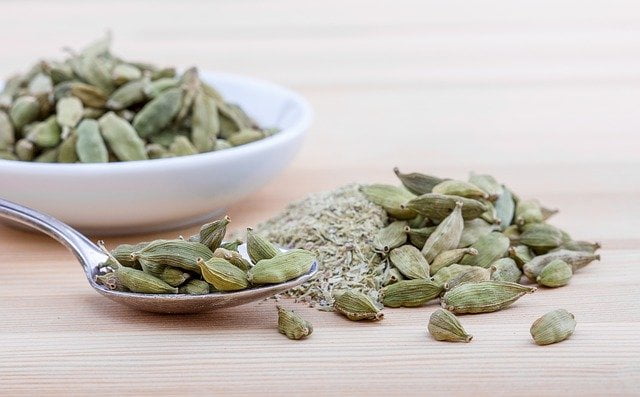
Cinnamon (Dalchni) – a sweet-tasting spice, with a warm, woody aroma, stimulates the senses and calms the nerves. The thinnest bark is the best quality cinnamon. It is available as a powder as well.

Cloves (Luong) – small, dried, reddish-brown flower buds of the tropical evergreen tree of the myrtle family.
They have a strong, sweet aroma and hot, pungent taste, Cloves are best bought whole.

Photograph by Brian Arthur CC BY 2.5
Peppercorns (Kali Mirchi) – pepper’s name comes from the Sanskrit Pippali nigrum, which means “black spice. Black pepper is more aromatic, white is stronger and hotter.

Mace is the fleshy lattice, covering of the nutmeg (hard nut), which is golden brown in color. Similar flavor to nutmeg.
The feathery reddish aril that covers each nutmeg seed is removed to make mace.

Image: nutmeg and mace
Encyclopedia Britannica
Saffron (Zaffran) – the most expensive spice in the world, pungent,
honey-like flavor and aroma.

Recipes
Making chai is straightforward; we only need a masala/spice blend, water, tea, milk, and sugar. We can go to the store and buy an already packaged chai or masala powder/Garam chai masala, add some hot water, milk (hot or cold), and sugar, and we are good to go. It is an easy and fast way of having a cup of tea when we are in a hurry; the only thing is we don’t have much control over the final product’s flavour.
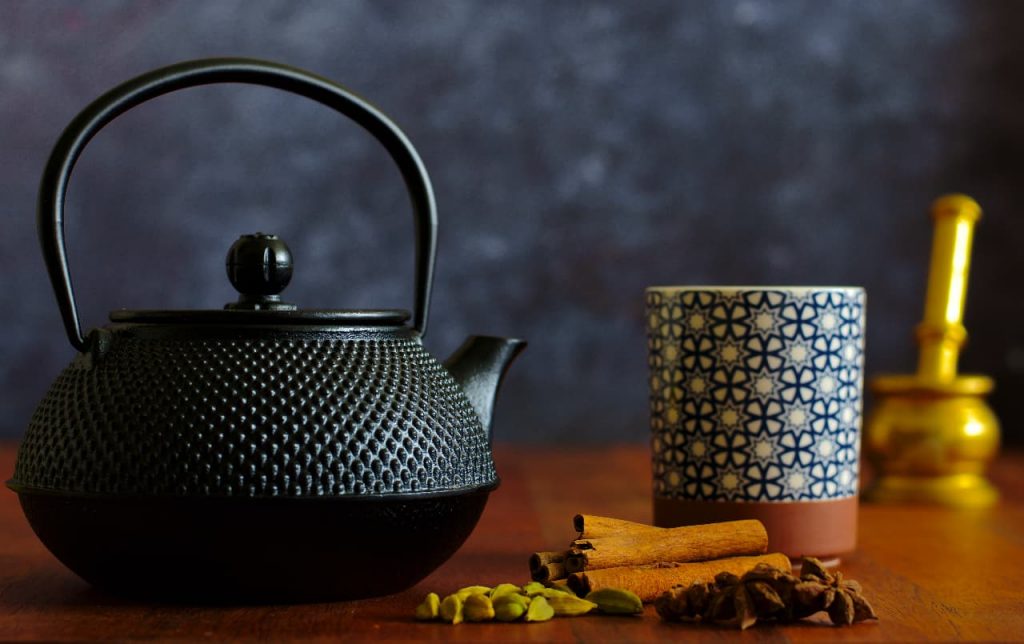
While working with recipes and flavours, I always ask myself, “Can I make it taste better or different?” I’m dependent on someone else’s flavour perception by using prepackaged masala; there’s not much I can do to change that. Making my spice blend allows me to be in control and modify the chai masala mix as I go.
There are usually five ingredients in chai: water, tea, milk, sugar, and a spice blend called masala. The most common spices are ginger, cardamom, and peppercorns. The traditional milk used in India is buffalo milk, and in some places, condensed milk is also added as a sweetener. If one is milk intolerant or prefers having black tea, skip the milk, use a non-dairy one, or add more water instead of milk.
To make chai with no milk, add the spices to boiling water and squeeze a wedge of lemon before serving.
Let’s look at some ideas and recipes for different spice blends I came across and enjoyed making.
Masala Mix – Garam chai masala

Garam is related to the blend’s hotness and warmness of the spices and masala. Making Garam chai masala at home allows one to make small batches of different herbs and use them like the store-bought ones.
The four recipes below are based on the most commonly used ingredients: ginger, cardamom, cloves, peppercorn, and cinnamon. Adding additional spices to these familiar ingredients is probably the easiest way to create Garam chai masala. Does every recipe follow this principle of blending spices? I’m unsure, as the masala recipes will depend on the choice of spices and herbs and personal taste preference.
How to Make Masala
2 ½ teaspoons of ground ginger – 10 g fresh peeled ginger
2 teaspoons of ground cinnamon
¾ teaspoon of ground cloves
¾ teaspoon of ground green cardamom
1 teaspoon of ground allspice
1 teaspoon of ground nutmeg
½ teaspoon of finely-ground black pepper4
Whole Spices
6 g Cloves
6 g Green Cardamom
6 g Black Peppercorns
2 g Fennel Seeds
1 stick Cinnamon
5 g Ginger powder
1/4 teaspoon Nutmeg grated
10 g cloves
20 g green cardamom
5 g black peppercorn
1/ 2 stalk of cut lemongrass
15 g dried ginger powder – 10 g peel fresh ginger
Whole Spices
8 g ginger
8 g cinnamon
8 g cardamom
8 g cloves
5 g black pepper
10 g cloves
20 g green cardamom
5 g black peppercorn
1 sticks cinnamon
15 g dried ginger powder – 10 g peel fresh ginger
1 teaspoon vanilla extract
1/4 tsp nutmeg powder
10 g cloves
20 g green cardamom
5 g black peppercorn
1 sticks cinnamon
10 g peel fresh ginger
2 g fennel seeds
2 g licorice
I usually use one of the following ways to prepare the spices before grinding them to a powder.
- Roasting
Using ground spices, cloves, cardamom, cinnamon, and peppercorn, heat a sauté pan and quickly toss them for about 30 seconds to a minute; oil is unnecessary. Please keep it in an airtight container. - Baking
If using whole spices, you can bake them in the oven. Preheat the oven to 350 F, place them on a tray, and bake for about 5 minutes; if they turn black, shorten the baking time. Please keep them in an airtight container.
Note: I prefer using the Roasting/Baking process before grinding as that brings out the aromatics, especially from the whole spices.
If the recipe calls for it, I add fresh Ginger and Nutmeg in the later steps. - Freezing
– Freeze the spices for about 2 hours and then blend them into a fine powder, using a spice/coffee grinder or pestle and mortar.
I use this method when I work with mastic to make Dondurma ice cream.
Grinding—After cooking, it is time to put them into a spice grinder; we can add ginger at that point. I prefer a freshly chopped one. After that, grate the nutmeg/mace into the powder. (Mace is the outer covering of the nutmeg.) and blend them into a fine powder. *Nutmeg powder can be sprinkled on the chai as a garnish. Nutmeg is the seed and can be substituted with mace in a 1:1 ratio.
Note: To save time, no thermal processing is required. Grind all the spices without roasting/baking, and keep them in an airtight container until needed.
Use 1/4 to 1 teaspoon of the mix later in the making process.
Tea Time – How to make Masala Chai
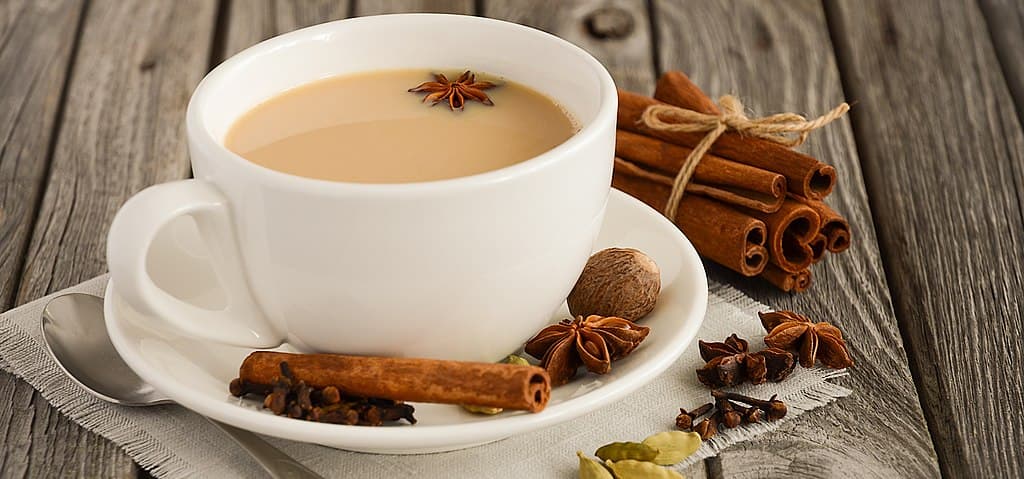
It is finally Tea Time; let’s make some tea. We only need Garam chai masala if desired -we just created water, tea leaves/bags, milk, and sugar.
I drink black tea and often make myself Black Masala Chai, but since it is not that common, let’s start with a regular recipe.
I do not include the store-bought chai here as every producer specifies their preferred way of making it on the box.
Masala Chai Tea
2 cups of water
2 teaspoons of loose tea leaves or 2-3 bags of black tea
1/2 cup to 1 cup milk
1 tablespoon of sugar or sweetener of choice
3/4 teaspoon masala mix
How to:
- Add tea and fresh spring water to a pot and bring almost to a boil*
- Add the masala mix of your choice and let it boil for 3 minutes. Turn on medium
- Add sugar and milk and boil on medium heat for 3-4 minutes, stirring occasionally, ensuring it doesn’t overflow.
- Strain and serve
Note: If your masala doesn’t have ginger, it can be added during the first boiling step.
*Water temperature while making tea will depend on the tea used. For Black tea – it is around 190F, and For green tea – it is between 170F-185F.
Masala Chai with no Milk
Make it the same way as the regular recipe; substitute milk with the same amount of water. Someone might wonder, why not with milk? A few reasons for people not wanting milk in their chai include diet and lactose intolerance. I know there are dairy substitutes, but they are usually loaded with hydrocolloids(carrageen, guar gum, etc.); at the end of the day, we can make our drink however we prefer.
From a flavour point of view, one more reason for no milk is that the spices are more potent and rich, and the aromatics shine through. Using milk traps the intensity of the herbs and creates a milder drink to a certain degree.
Black Masala Chai
3 3/4 cups water
1 1/2 oz of honey or maple syrup
3 teaspoon Green or Black tea – optional
Masala mix-use one of your choices
8 g ginger
8 g cardamom
8 g cloves
5 g black pepper
1/2 stalk of lemongrass – finely chopped
How to:
- Pour water into a pot and bring it to a boil; in the meantime, peel and grate the ginger over the water.
- Add the rest of the spices and the lemongrass.
- Boil for 2-3 minutes and simmer on low for about 45 minutes; add sweetener at this point – skip it for a lower-calorie drink.
- 5 to 10 minutes before finishing simmering, add the tea and let it steep. This is an optional step; you can skip the tea and drink it like that, cold or hot.
In effect, we are making infused syrup, which can also be used in several cocktails. - Serving—Fine strain and serve immediately, or let it cool down and put it in the fridge for the next day. Serve it cold or heat it again.
- Squeeze a lemon wedge over the chai before serving.
There are many uses of chai masala mix; besides cooking or making chai, it is a truly versatile ingredient and is often incorporated in recipes such as:
- ice cream
- mixed with matcha tea for a smoothie
- in cocktail recipes as syrup
- making mulled wine
- punch
- in Apple cider
I used masala to make foam in Short Island Iced Tea and some of the Apple Cider Recipes I made.
Footnotes
- masala chai
- chai history
- spices
- make chai

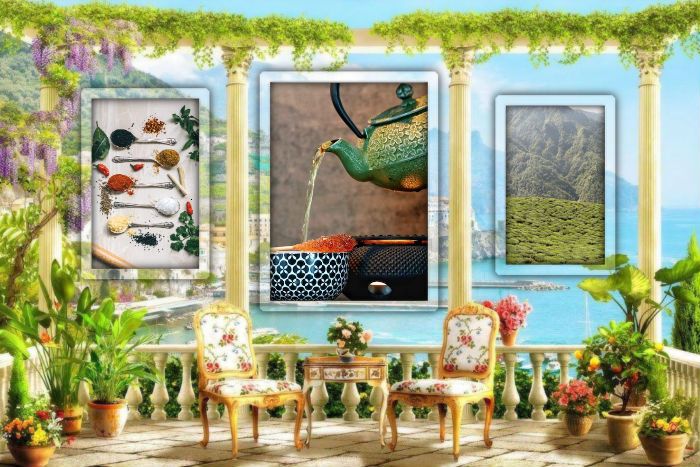

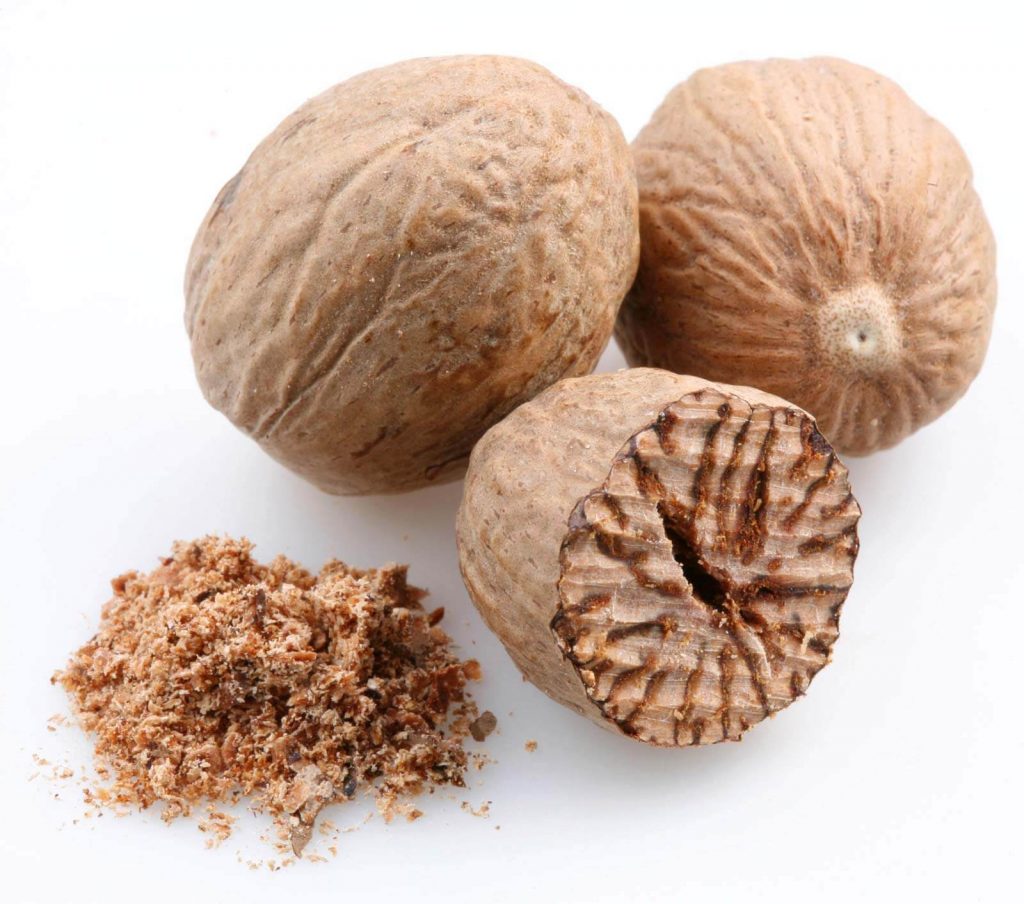



Neat blog! Is your theme custom made or did you download it from somewhere?
A theme like yours with a few simple adjustements would really make my blog jump out.
Please let me know where you got your design. Many thanks
My theme is custom made.